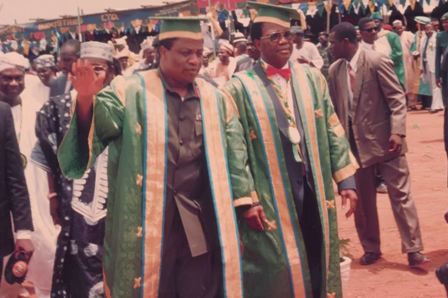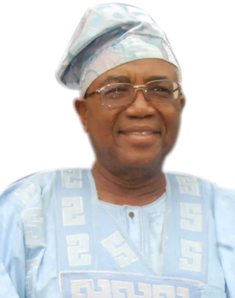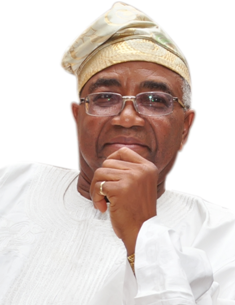Last Updated on February 6, 2013 by admin

FLASH BACK: Erstwhile Visitor to the University, former Military President and Commander-in-Chief of the Armed Forces, General Ibrahim Badamosi Babangida (now rtd), accompanied by the Pioneer Vice-Chancellor, Professor Nurudeen `Nimbe Adedipe at the University function in the early years of the establishment of the Institution. Behind them are the then Governors of Ogun and Lagos States, Chief Olusegun Osoba and Sir Michael Otedola, respectively.
|
Professor Nurudeen Olorun-Nimbe Adedipe midwifed the establishment of the University as its Pioneer Vice-Chancellor. As the Chairman of Nigerian University Commission (NUC) that recommended the demerging of the Federal Universities of Technology and their conversion to specialized Universities of Agriculture, he witnessed the conception of the old UNAAB in the belly of the then General Ibrahim Badamosi Babangida Military Government; he nurtured the pregnancy, saw the travailing and took delivery of the University in the cool morning of January 1, 1988. > Nobody chronicles FUNAAB’s Birth better than the midwife himself, Professor Nurudeen Olorun-Nimbe Adedipe; Happy reading.
Inceptional Activities Having established the University with effect from January 1, the immediate challenge was the assumption of duty by the Vice-Chancellor to set the machinery in motion for restructuring the original FUT, which transited through a College of Science and Technology, into University of Agriculture with the new vision, structure, programmes, activities and services commencing on October 1, 1988 So, here comes the challenge – the University of Agriculture as a reality-what nature? The nature of the university was, indeed, a knotty and nutty one because I had not given thought to it beyond the universally acknowledged responsibilities of Agricultural Universities to be those of teaching, research and extension. Since I was, then, faced with the realities, I had to start serious thoughts.
Rationalization of Programmes and Choice of Permanent Site The first task towards the evolution and establishment of a befitting University of Agriculture, Abeokuta (UNAAB), was to rationalize the various courses of the Federal University of Technology, Abeokuta (FUTAB), into a new structure under the University of Lagos, and answerable to its Governing Council during the transition period of 9 months. The new structure comprised the School of Technology (with Departments of Agricultural Management; Agricultural Technology and Food Technology); and a School of Applied and Natural Sciences (with Department of Geology and Mineral Sciences; Hydrology and Water Resources Management, and Natural Sciences). This task was accompanied in the physical development sector by the immediate choice of one of the three alternative sites proposed as the permanent site of the university. The three were: (i) The Ilaro road axis (from near Ita Osin); (ii) The Ayetoro road axis (from near Ibara Orile); and (iii) The Ibadan road axis, off Osiele. The Ilaro road axis was eliminated for the reasons of high density of population and structures that would lead to the displacement of many people, and the demolition of many structures with high monetary compensation; while the Ayetoro road axis was bedeviled with the location of the Sokoto Highway which would have gone through the campus, and inherent dangers of periodic hazards that might be caused by the breaking of Ogun-Osun dam. As I write this part of the book came the news that water discharged from this Oyan dam which recked havoc in Ogun and Lagos States. In the latter, the foremost high density Lagos-Ikorodu road became flooded for over two weeks soaking the Ketu, Mile 12, Owode and Ajegunle communities with considerable loss of properties. Thank God, for our God-guided choice. The Ibadan road axis, off Osiele with Alabata as the dominant village, had everything going for it, including size (close to 10,000 ha and 41.5 kilometer perimeter, topography, hydrology, rurality, access from Lagos, Abeokuta, Ibadan, Eruwa and the entire Oyo North); and distinctly suitable for agricultural purposes as determined by a University of Ibadan Consultancy Team of Soil Pediologists, and being in the ecological transition of the rainforest and the savanna. As Vice-Chancellor, therefore, I confirmed earlier work by the University of Lagos, and formally recommended the site for the approval of the NUC, which was promptly granted. The burning and contentiously sensitive matter of the choice of permanent site was, thereby, quickly laid to rest. Meanwhile, on the academic front, the NUC directed the two UOAs to submit their proposal for academic programme and physical development of their permanent sites. For Makurdi, the later was not a problem because it had, since 1985/86, begun the development of its permanent site with some structures and infrastructures already in place, under the precursor FUT Makurdi and the fostering University of Jos. That facilitating element was glaringly missing in the University of Lagos/Abeokuta case.
Academic Programmes The NUC arranged visits of the Executive Secretary (Prof. Idris Abdulkadir) with the two Vice-Chancellors (Profs. Adedipe and Idachaba), to USA (the founding home of Land-Grant Universities dating back to the Morrill Act signed by President Abraham Lincoln in 1862); the Netherlands (for its world renown Waageningen Agricultural University); and India with then 26 Agricultural Universities (for the resounding achievements since they were variously established in the early 1960s). As might be expected, the details of their individual nature deferred, but the concept was similar to the effect that the UOAs do engage in teaching/training, research and extension; what we in UNAAB named TRIPODAL MANDATE for the overall mission of agricultural and rural development, towards sustainable national development. Arising from the lessons of experience garnered, coupled with the personal exposures of the Executive Secretary and the two Vice-Chancellors as students, in related systems, we took the bull by the horn. In UNAAB, the VC worked on a draft proposal, which was considered by the then Committee of Deans, on May 29, 1988. Present at this meeting held on Sunday noon, after most Church services (our pioneering work was generally no respect of time of day/night, or day of the week!), were Prof. N. O. Adedipe, VC (Chairman), Ms C. A. Gbadebo (Deputy Registrar), Dr. P. A. Okuneye (Ag. Dean, School of Technology) and Dr. O. O. Oguntade (Ag. Dean, School of Applied and Natural Sciences). In attendance were Mr. A.W O. Attoye (PAR Academic), Mr. F. O.E. Idehen (SPO, Academic), Mrs. I. A. Salaam (SAR, Gen. Admin.), Mr. S. A. Ilori (AR, VCO) and Miss O. O. Lawore (AO Protocol). The meeting considered my draft blueprint. It is worth mentioning that in a dream, there was an open book in which the institutional components were revealed to me; and I woke up immediately to transcribe as much as I could recollect. I later worked it to fine-tuning completion. That became the draft. The objectives, according to the VC, were the: (a.) Determination of the rationale for University of Agriculture vis-à-vis roles of Universities of agriculture in other parts of the world; (b.) Definition of concept and philosophy of a University of agriculture; (c.) Determination of the goals of the University of agriculture in the Nigerian context; and (d.) Determination of the strategy and machinery for achieving the goals. UNAAB would have to maximize the limited available resources to build a basic structure that would stand the text of time, while focusing on the central missions of agricultural production, teaching, research, and extension services. Furthermore, units to be created in the University of Agriculture should contain unique elements which would be distinct from existing faculties of agriculture in conventional universities. The draft proposal made provisions for 9 Colleges constituting the primary unit and 50 Departments as secondary unit (at maturity). The details are contained in the book That UNAAB May Excel by Adedipe, 1995, pages 21-27. The draft proposal was substantially adopted and represented to the NUC tripartite meeting (NUC, UNIAGRIC, Makurdi and UNAAB) on May 31, 1988. The proposal was preliminary rationalized into 6 colleges, 2 Academic Centres (for research and extension, respectively) and 35 Departments, as first phase.
The Vice-Chancellor, thereafter set up a 40-person Panel to consider the Academic proposal and transform it into a Draft Academic Brief, July 3-8, 1988. The panel comprised Prof. S. K. T. Williams (UI Ibadan), as Chairman; and the following from Ibadan; Profs. G. M. Babatunde, C.T.I. Odu, G.B. Ogunmola, L. C. Nwobushi, S. S. Ajayi, Tomi Adekanye (Mrs.), J. A. Ekpere, M. O. Adeniji, O. Akinyele, O. Oduye, F. O. Aboaba and Dr. T. O. Tayo; from OAU, Ife- Profs. A. A. Adegbola (late), C. A. Adebona, I. A. Akinbode (late), A. A. Ademosun; from ABU Zaria – Prof. L. B. Olugbemi (late); Prof. C.O.G. Obah (FUT Owerri); Prof. O. A. Famoriyo (late); (FUT Akure); Prof. B. A. Adenuga (late), Ogun State University, Ago-Iwoye; Prof. O. Ogunfowora (Peat Marwick Ani and Ogunde), Lagos; Mrs. B. A. Oni (FMARDWR, Abuja); Dr. T. O. Coker, Nigerian Veterinary Medical Association, Lagos.
The following were unavoidably absent; from Ibadan, Dr. J. C. Igbeka and Prof. A. Youdeowei; from OAU Prof. Niyi Oshuntogun, Mrs. P. A. Ladipo; from ABU, Prof. J. A. Ogunronbi, Prof. Y.O. Aliu, Prof. O.I. Leleji (late), Prof. L.G. Lombin, Dr. L. L. Odigie and Dr. N. B. Mijindadi (late); from University of Nigeria, Nsukka, Prof. F.O.C. Ezendinma (late), Prof. P.O. Ngoddy and Prof. W.O. Enwezor; from the University of Calabar, Prof. U. K. Enyinihi. During the meeting, the panel undertook a tour of the proposed permanent campus site. The panel was graciously invited to the expansive, mixed and automated Obasanjo Farms, Otta, where it assessed the facilities there, followed by national development discussion session, which turned out to be most enlightening and entertaining, with the added hospitality of General Olusegun Obasanjo (Rtd). The panel submitted its report on July 8, 1988.
|
  
Prof ‘Nimbe AdedipeFirst Vice Chancellor, FUNAAB |
